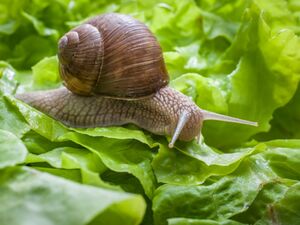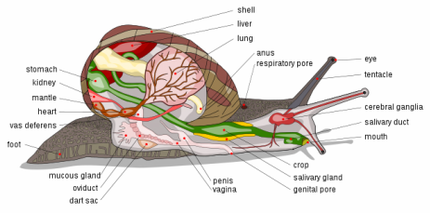Garden snail
Cornu aspersum, known as the garden snail, is one of the most widely known species of all terrestrial mollusks. As a member of the Helicidae family, Cornu aspersum is included with many other common land snails. Previously, Cornu aspersum was classified under Helix aspersa, however, it is now classified under the genus Cornu.
Originally from the Mediterranean and parts of Europe, Cornu aspersum has been accidentally introduced in many parts of the world. Because of this, it is widely regarded as a garden and agricultural pest. However, in some places, the garden snail is a food delicacy.

Taxonomy
Kingdom: Animalia
Phylum: Mollusca
Class: Gastropoda
Order: Stylommatophora
Family: Helicidae
Genus: Cornu
Species: C. asperum
Description
Adults have a thin but hard calcareous shell that can be 1-1.5 inches in diameter and 1-1.375 inches high [1]. Their shells vary in color and shade but are typically a reticulated pattern of dark brown, brownish-golden, or chestnut with yellow stripes, flecks, or streaks. The body of the garden snail is soft, slimy, and brownish-gray in color. Its soft body can be fully retracted into its shell which it does whenever it is resting or feels threatened. Another mechanism the garden snail uses when threatened, injured, or irritated, is a defensive froth of mucus that might repel some enemies or overwhelm aggressive small ants and other insects [4].

Unlike other species within the class Gastropoda, garden snails do not have an operculum or seal that certain mollusks use to keep in moisture and defend themselves against small predators. Instead, during dry or cold weather, garden snails seal the aperture of the shell with a thin membrane of dried mucus, called an epiphragm.
Life Cycle and Reproduction
Members of Cornu aspersum are hermaphrodites, meaning they produce both male and female gametes [2]. Because of this, reproduction is usually sexual, however, self-fertilization is possible. Mating sessions often occur over several hours in which sperm is shared between each snail; garden snails are also one of the only species that use "love darts" in mating. "Love darts" are sharp darts produced by the snail's body to aid in reproduction [7].
Two weeks after fertilization, garden snails lay around 80 spherical white eggs in small spaces including topsoil and under rocks. Within a year, a garden snail can lay around six batches of eggs, with the eggs being about 4mm in diameter. Upon hatching, young garden snails take one to two years to reach maturity and begin the reproductive cycle again.

Habitat
Cornu aspersum is native to the Mediterranean region and its present range stretches from northwest Africa and Iberia, eastwards to Asia Minor and Egypt, and northwards to the British Isles. However, the garden snail can now be found in other regions of the world including Australia, North America, Costa Rica, and South America due to deliberate or accidental introduction [3]. Due to their deliberate or accidental introduction in various regions, the garden snail is now cosmopolitan in temperate zones and has become neutralized in regions with climates that differ from the Mediterranean climate in which it originated.
Garden snails are usually seen at night in the spring, summer, or autumn, but are most active in warm, damp weather. Under these conditions, garden snails prefer to reside in compost heaps and grassy areas such as gardens, fields, and river banks [8].
Feeding Habits
The common garden snail is primarily a herbivore that feeds on vegetable crops, garden flowers, leaves, algae, lichen, and fungi. This species can be omnivorous as it will feed on other snails and empty snail shells [8].
Human Importance
The common garden snail is a species most notably known to humans as an agriculture and garden pest, an edible delicacy, and also occasionally a household pet. When it comes to being used as a food delicacy, garden snails are used as the main ingredient when making escargot which is most commonly known for being a special French cuisine enjoyed worldwide. In regards to being considered an agriculture and garden pest, attempts to reduce damage to crops and other plants have been instilled. Pesticides and other control options such as caffeine and copper are used to prevent garden snails from reaching foliage and fruit to consume. Even other species of snail such as the Decollate Snail are used as predators to prevent garden snails from infesting areas [5].
References
[1] Garden Snail (cornu aspersum) n.d. iNaturalist. https://www.inaturalist.org/taxa/480298-Cornu-aspersum#Description
[2] Brown garden snail - cornu asperum (Müller). https://entnemdept.ufl.edu/creatures/misc/gastro/brown_garden_snail.htm
[3] CABI, 2015. Cornu aspersum (common garden snail). https://www.cabi.org/isc/datasheet/26821
[4] Ansart, A.; Vernon, P.; Daguzan, J. (2002). "Elements of cold hardiness in a littoral population of the land snail Cornu aspersum (Gastropoda: Pulmonata)". Journal of Comparative Physiology B. 172 (7): 619–625.
[5] Liu, Lucy; Sood, Anshum; Steinweg, Stephanie (2017). "Snails and Skin Care—An Uncovered Combination". JAMA Dermatol. 153 (7): 650. doi:10.1001/jamadermatol.2017.1383. PMID 28700796.
[6] Welter-Schultes, F. "Genus taxon summary for Cornu. version 12-01-2014". AnimalBase.
[7] Kaufman, Rachel. “Bizarre Valentine: Why Mating Snails Stab with 'Love Darts'.” LiveScience, Purch, 14 Feb. 2013, https://www.livescience.com/27132-snail-mating-love-darts.html.
[8] Mollusks : Carnegie Museum of Natural History, https://www.carnegiemnh.org/science/mollusks/landsnailecology.html
